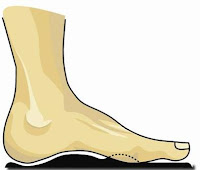 The arch on the right is in Bagdad. It was built in 2000 B.C. (4,010 years ago!) and is the oldest known arch in existence. However, the ancient Romans were the first to use arches in a variety of structures like aqueducts and buildings.
The arch on the right is in Bagdad. It was built in 2000 B.C. (4,010 years ago!) and is the oldest known arch in existence. However, the ancient Romans were the first to use arches in a variety of structures like aqueducts and buildings.Architects know "that by using the arch configuration, significant spans can be achieved. This is because compressive forces hold it all together in a state of equilibrium". (Wikepedia/Arch)
Arches like the one in Bagdad or the Roman aqueducts have stood for centuries due to the incredible strength characteristics that arches provide regardless of the material used. The strength of the material is tripled when formed into the shape of an arch.
The body has many arches for the same reasons (strength and durability): The spinal column is made up of arches. the skull is curved in an arch and of course the foot has several arches.
In architecture and in the body if the shape of the arch is compromised the arch strength  is compromised. If this happens in the body, the body will bend and shift in unnatural and painful ways.
is compromised. If this happens in the body, the body will bend and shift in unnatural and painful ways.
Unlike many over the counter orthotic insoles, Pedag has many orthotics that have a semi-rigid longitudinal arch support and have a metatarsal arch pad because Pedag wants to add to the strength of your natural arches. A cushioning insole might feel nice but it does not provide the foot with the extra strength it needs to fight the affects of gravity, weight and the erosions of time.
For orthotics that provide your feet with the strength they need to support your body in the correct alignment (of feet, ankles, knees, hips, back and neck) look to these Pedag insoles:
 is compromised. If this happens in the body, the body will bend and shift in unnatural and painful ways.
is compromised. If this happens in the body, the body will bend and shift in unnatural and painful ways.Unlike many over the counter orthotic insoles, Pedag has many orthotics that have a semi-rigid longitudinal arch support and have a metatarsal arch pad because Pedag wants to add to the strength of your natural arches. A cushioning insole might feel nice but it does not provide the foot with the extra strength it needs to fight the affects of gravity, weight and the erosions of time.
For orthotics that provide your feet with the strength they need to support your body in the correct alignment (of feet, ankles, knees, hips, back and neck) look to these Pedag insoles:
Holiday, Master, Pro-Active XCO, Solar Plus, Vitality, Viva



